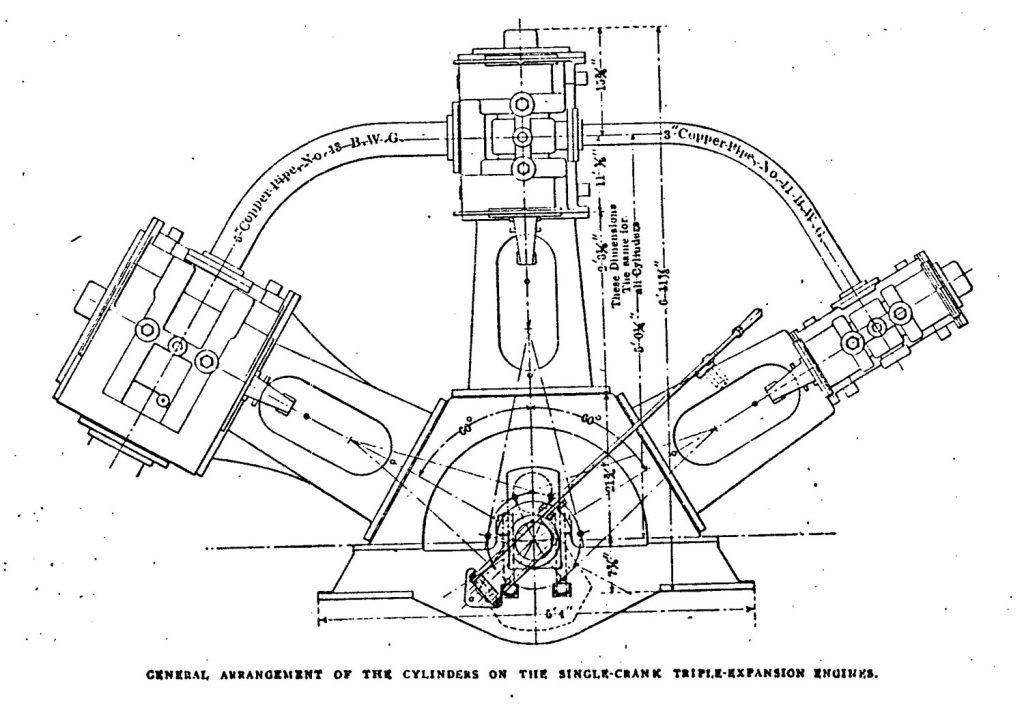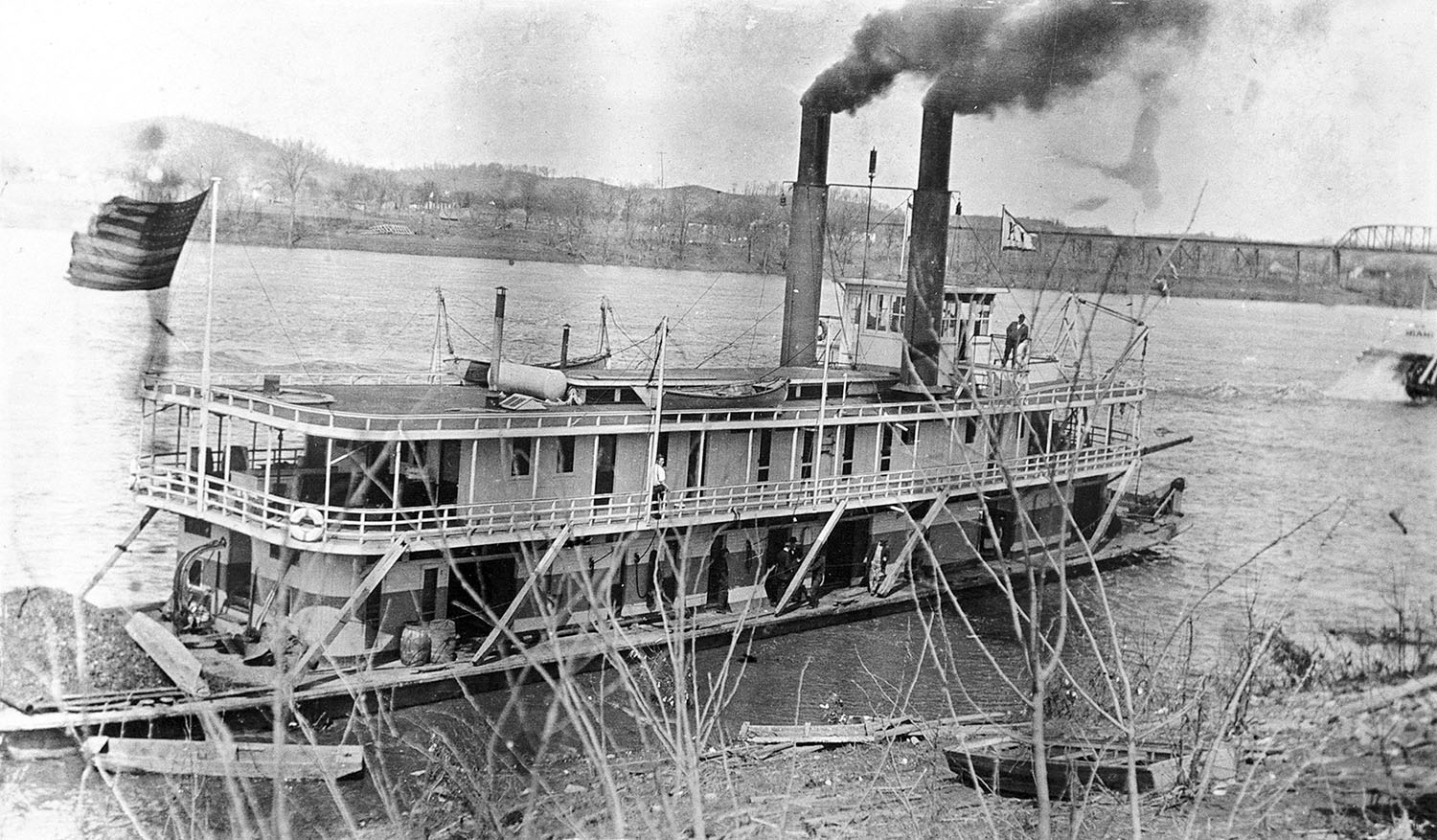We detailed the A.M. Scott in the April 10, 2023, issue of The Waterways Journal. This boat was an early steam twin-prop towboat, described in Way’s Steam Towboat Directory as the third tunnel hull boat built by the Charles Ward Engineering Works at Charleston, W.Va., on the Kanawha River. John L. Fryant, who is well known for his expertise in model building, and who has also extensively researched the Ward firm, recently forwarded some interesting information on the Ward engines that powered the A.M. Scott, as well as biographical information on the man the boat was named for.
The A.M. Scott was built in 1906 with a riveted steel hull that was 150 by 26 feet. In the material sent by Fryant was an article from the May 1907 issue of International Marine Engineering, describing the new boat in detail. The cabins were reported as “built throughout with the best California redwood, the carlins and framing of Oregon fir. The pilot house is ten by twelve feet, fitted with steering wheel, steam steering gear and all necessary bell pulls and signals to the engineroom.”

One of the most impressive features of the boat was to be found in the engineroom. Not only was it outfitted with a Ward sectional watertube boiler with a working pressure of 275 pounds, but the engines were of a unique Ward design. These engines were “Ward’s single crank, single eccentric, triple expansion engines.” Where most triple expansion engines were built with an in-line layout, this engine from Ward was of a radial design, with cylinders 8-5/16, 14-1/2, 25-1/2 – 14-inch stroke. Advertising from the Ward Engineering Works described it as “The simplest marine engine built.” Way’s lists the boat with a total of 800 hp., indicating each engine was 400 hp. The twin props were each 60 inches in diameter.
The International Marine Engineering piece stated that the boat was built as a substitute for the “old style sternwheel boats now in use on the western rivers.” Ward had been an early advocate of tunnel-stern, prop-driven boats. The article also said that the A.M. Scott had “demonstrated beyond a doubt that a twin-screw boat can be built with all the handling qualities and power of the sternwheel towboats.” The rudders of the boat were arranged both “forward and aft of the propellers” in a way to allow the boat to “steer her tow around bends that the older boat could make only by backing and flanking.”
From all indications, the A.M. Scott did perform well, but despite the brags and hype at the time, most large towboats would continue to be built of the sternwheel type for the next three decades.
The information that Bryant sent regarding the boat’s namesake was as interesting as the descriptions of the power plant. Addison M. Scott was born in New York state in1843, and he worked on his father’s farm as he was growing up. He attended the Ithaca (N.Y.) Academy, where he concentrated his studies on mathematics and surveying. In 1866, he joined a party of surveyors at St. Paul, Minn., embarking on a survey of the Upper Mississippi River for the U.S. Engineers under Gen. G.K. Warren.
In 1867, Warren offered Scott a position as assistant engineer on Upper Mississippi improvements then underway. He was involved in the construction of a railroad and highway bridge at Rock Island, Ill., and Davenport, Iowa., and after the completion of that project in 1873 he became the resident engineer on the Great Kanawha River improvements, which included the original system of locks and dams on the Kanawha. He would continue at this until 1901, when he resigned. He continued to make his home at Charleston, W.Va., until moving to Orlando, Fla., for several years before his death in 1927. (These biographical details are from documents in the Addison Moffat Scott Collection in the Marshall University James E. Morrow Library, on permanent loan from Gerald W. Sutphin.)
As chronicled in the April 10 column, the towboat A.M. Scott was first a pleasure boat out of New Orleans, and after 1911 was in service to the Kansas City & Missouri River Navigation Company. It was transferred to the Inland Waterways Corporation (Federal) after 1920, and then ran St. Louis to New Orleans, and even some in the Warrior-Tombigbee Rivers. Federal retired it in 1928, and it was sold to Bisso at New Orleans.
In his correspondence, Fryant noted that in 1930, the Ward concern built a small diesel sternwheel boat for the U.S. Engineers that was assigned the name Scott. He wonders if it were also named for the same person as the A.M. Scott of 1906. Given that Mr. Scott spent 34 years as a civil engineer with the Engineer Department, and that he had just passed away in 1927, the likelihood is good that it was. The Scott of 1930 is still around as the private pleasure boat P.A. Denny.
Capt. David Smith can be contacted at davidsmith1955obc@gmail.com.




